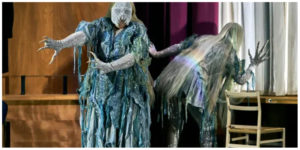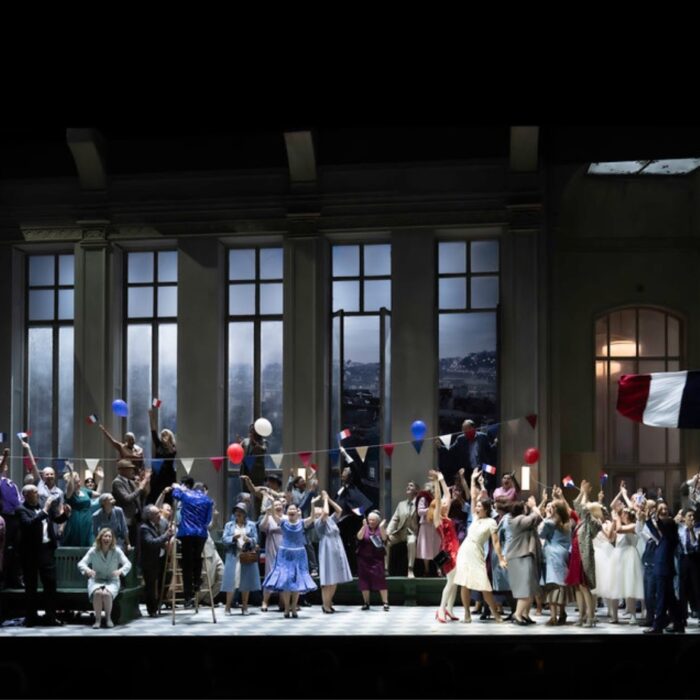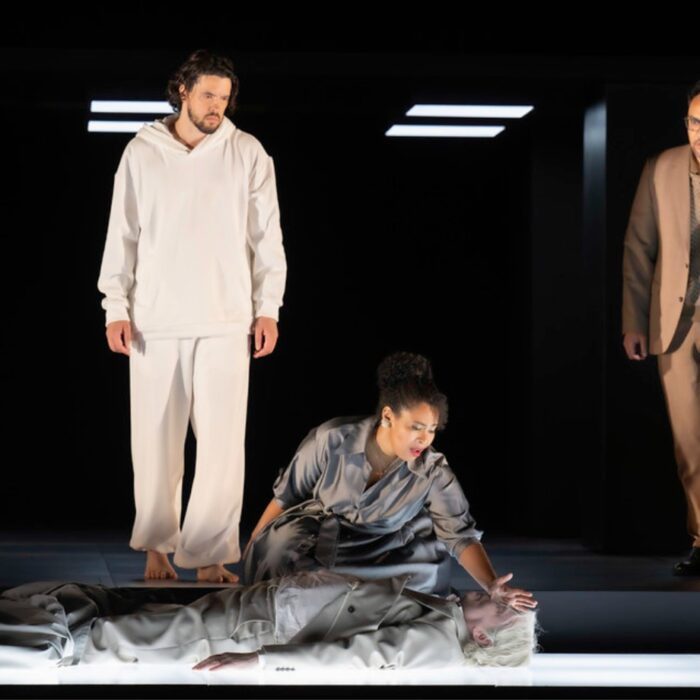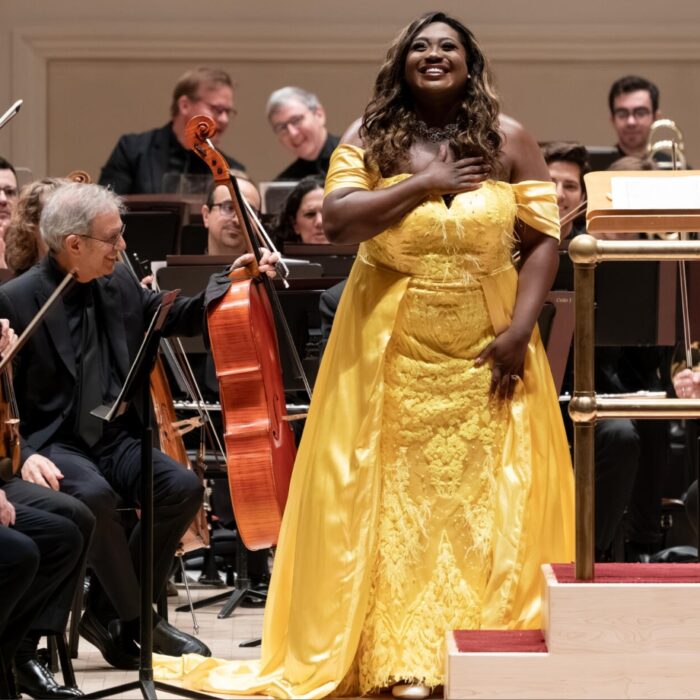
Bayreuth Festival 2022 Review: Götterdämmerung
Irene Theorin Shines Once More in Valentin Schwarz’s Production Which Ends in Confusion
By Mauricio Villa(Credit: Enrico Nawrath)
With “Götterdämmerung,” any chance of Valentin Schwarz giving an understandable meaning to his production went nowhere.
For the first time in the tetralogy, Schwarz presented paranormal elements like the three Norns (represented as three faceless woman wearing sparkling costumes and makeup) or the transformation, thanks to the magic helmet, of Siegfried into Gunther for the last scene of Act one.
More Incoherence
But despite these “saving graces,” the rest of the performance was just more nonsense full of inconsistencies. The Rheingold / Ring goes back to being a small child, this time, a blond girl. I got the impression the she was Brünnhilde and Siegfried’s daughter from the way they interacted with each other (of course this is just mere speculation because there is nothing in the text to support this theory). The kid is kidnapped by Siegfried-as-Gunther after having been blindfold and tied to a chair, maybe to avoid seeing how Siegfried/Gunther tries to strangle Brünnhilde with a scarf after having hit her head against a wall repeatedly.
For the final scene, the kid falls dead in front of the three Rhinmaidens at the very top of the set (which is an empty swimming pool) while Brünnhilde sings her Immolation scene in the middle of the stage besides Siegfried’s dead body. The director had the gruesome but absurd idea of having Brünnhilde sing the last part of her scene with the severed head of Grane, who was her butler or assistant in this production instead of her horse; it felt like I was watching “Salome.” As Brünnhilde lies holding the head against her chest besides Siegfried’s body, it seemed that what she yearns for is both her husband and her butler, adding to the confusion of what the production was aiming for.
The realism that had been present during the preceding operas was completely broken in the second scene of Act two where the set is just three white big walls and the Gibichungs are represented as a group of people wearing dark cloaks and masks who enter the stage under dense smoke. It was an effective theatrical effect, but it made little sense with the realistic and humanized lecture that had been offered to this point; here was Schwarz not only contradicting Wagner, but also himself. At this point it’s valid to ask… was there really any thought put into this or was it done as they went along?
Then there’s the overarching imagery that starts and ends the tetralogy. “Das Rheingold” began with a video projection of two fetuses fighting inside the womb (one of them scratches the other’s face right besides his eyes, justifying Wotan’s lost right eye). I had to read program notes to understand that these fetuses were the twins Wotan and Alberich (to be clear – they are not twins in Wagner’s poem at all). During the last bars of “Götterdämmerung” a final video projection shows the two fetuses holding each other.
Yes, Wagner’s opera ends with the preponderance of the “redemption by love” leitmotif, but is this really all of that messy rewriting of a 15- hour saga led to? A simplistic ending to a quarrel between unborn twins? I really do not have an answer to this and neither did the audience at Bayreuth, which burst out screaming “boo” and “whistling” as soon as the curtain fell at the end of the opera. It was one of the strangest and biggest signs of disapproval that I have ever seen inside an opera house. But the discontent of the audience did not finish there, as they expressed their dissatisfaction with some of the singers and the conductor.
Irene Theorin Shines
Irene Theorin reprised the role of Brünnhilde with her powerful dramatic instrument, potent ringing high notes and an emotional deep characterization. She easily navigated the difficult tessitura of her opening duet with Siegfried which is written mostly inside the stave and with an insistency in resolving down to low Ds, Cs or C flats, showing her warm and projected middle-row register. She effortlessly sang the first high notes of the night and deliver a strong sustained high C at the climax of the scene. The final scene of Act one continues this demanding vocal writing which demands moving the voice throughout the range from low to high; however, there’s a big dramatic arc as Brünnhilde’s state of mind begins to change from happiness and to diverse states of anger, regret, or frustration in her confrontations with her sister Waltraute and Siegfried.
But it is in the second act where the soprano is put the test both vocally and dramatically, and Theorin’s singing became aggressive and violent in her “mad scene” when she discovers Siegfried’s betrayal. Her singing became potent and full of desperation, expressing hate, anger and revenge. She was brilliant in the Immolation scene that closes the opera and her voice had no signs of fatigue after a long night of hard singing; she delivered such lines as “Ruhe, ruhe, du Gott,” with exquisite mezza voce lines and then delivering explosive ringing high As and Bs.
American tenor Stephen Gould sang the tragic hero Siegfried. He possesses a true “Heldentenor” voice with a dark, baritonal timbre and a resonant lower and middle register. But Gould’s voice is showing major signs of wear-and-tear from years of singing heavy dramatic roles for years. His lower and middle register are intact but from G upwards the vibrato becomes slow and wobbly, he loses projection (therefore his high notes are not powerful anymore), and you can really notice how he pushes the sound to reach those high notes. There are two high Cs written for Siegfried in this score. Gould escaped the first high C in the second act by simply not hitting the note and varying the melody, while he tried to sing the third act high note with irregular results as the note was extremely short, strained, and flat.
But it was in his third act scene and Hagen, Gunther and the male choir when his vocal challenges were more evident. Siegfried has to sing the melody of “the bird of the forest,” which requires singing sweetly between F sharp and high A natural constantly. There’s barely any orchestration so Gould’s voice was completely exposed, showing his difficulty with singing lyrically in such a high tessitura; his vocal tension and strain was more evident than at any other point in the opera.
Albert Dohmen, who previously sang Wotan at Bayreuth in two different productions, took on the role of the evil Hagen. It is very rare for a singer to sing these two different roles, but Dohmen proved in his performance how his voice has widened, become more dramatic, all while maintaining a compact high register and hitting several forte high Fs even a high G natural just before he stabs Siegfried in the back. He delivered an astonishing vocal characterization of the envious, greedy, and evil half-Nibelung with memorable moments like “Hier sitz’ich zur Wacht.” His intervention that closes the second scene of the first act was deliciously sinister and dramatic.
After a strong performance as Fricka in the first two operas of the tetralogy Christa Mayer gave a magnificent characterization, both vocal and dramatic, of Waltraute. She was dramatic and powerful as well as vulnerable at the same time in her intent to convince Brünnhilde to return the gold to the Rhine.
Soprano Elisabeth Teige, who had appeared in “Das Rheingold” as Freia, sang the role of Gutrune with her voluminous, lyrical voice offering a seductive characterization of the role.
Michael Kupfer-Radecky was a solvent Gunther with a warm dark timbre and modest volume, portraying a clownish Gibichung who looked like an old fashion rock star.
Okka von der Damerau, Stéphanie Müther, Kelly God, Lean-ann Dunbar, Stephanie Houtzeel and Katie Stevenson were brilliant as the three Norns and Rhinmaidens respectively in their short but important appearances.
Conductor Cornelius Meister concluded the tetralogy with an exhaustive exposé of the timbrical richness contained in Wagner’s score, creating moments of great tension in such scenes as the opening of Act two and the concluding trio of that same act. He and the orchestra also delivered moments of beautiful lyricism, especially at the very end of the opera where the themes of the Rhinemaidens and “Redemption by love” intertwine. He paid attention to dynamics and crescendos but somehow, I got the impression that his work in this opera was more about creating atmospheres and timbrical richness / vertical sonority, compared to the preceding operas where he focused more on tempi and dynamics. And the audience seemed to be unhappy with his work as they gave him major signs of disapproval at the curtain call.
Inversely, the orchestra and chorus, which were inexplicably clean, precise, and strong throughout, received a truly deserved ovation by the audience at the curtain call.
Ultimately, this entire production was full of “original parallel dramaturgy;” the final opera in the tetralogy, with its sudden shift away from the “realism” of the other works and its grotesque ending, was probably the most unsatisfying of all. That said, the splendid cast of Wagner experts made it all go down much easier. Irene Theorin is undoubtedly the standout here, as she was in “Die Walküre.”


